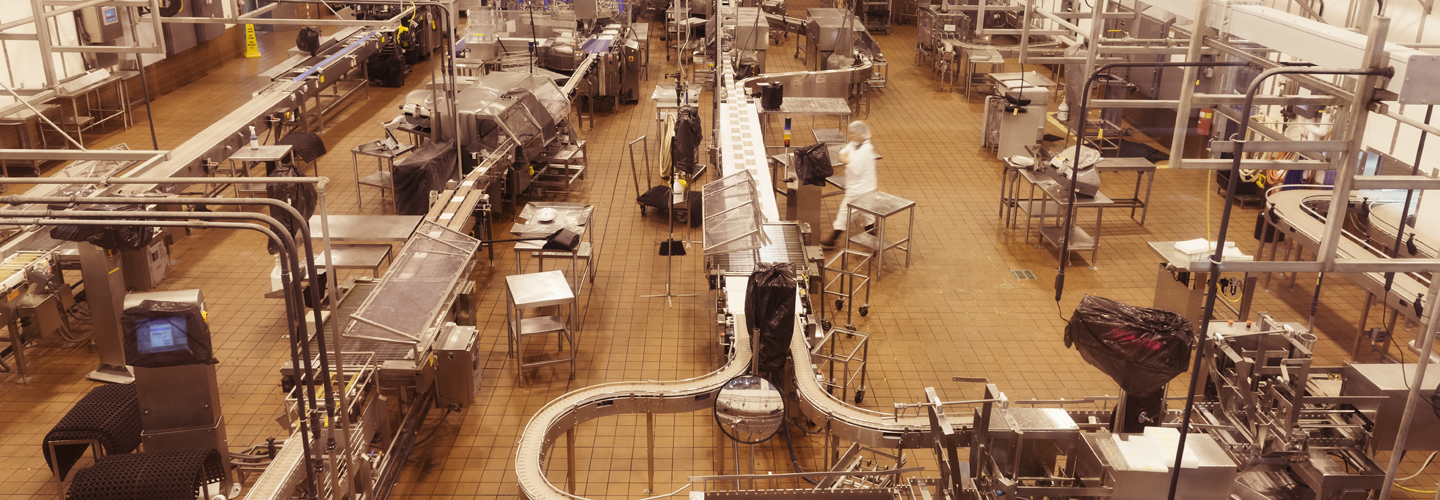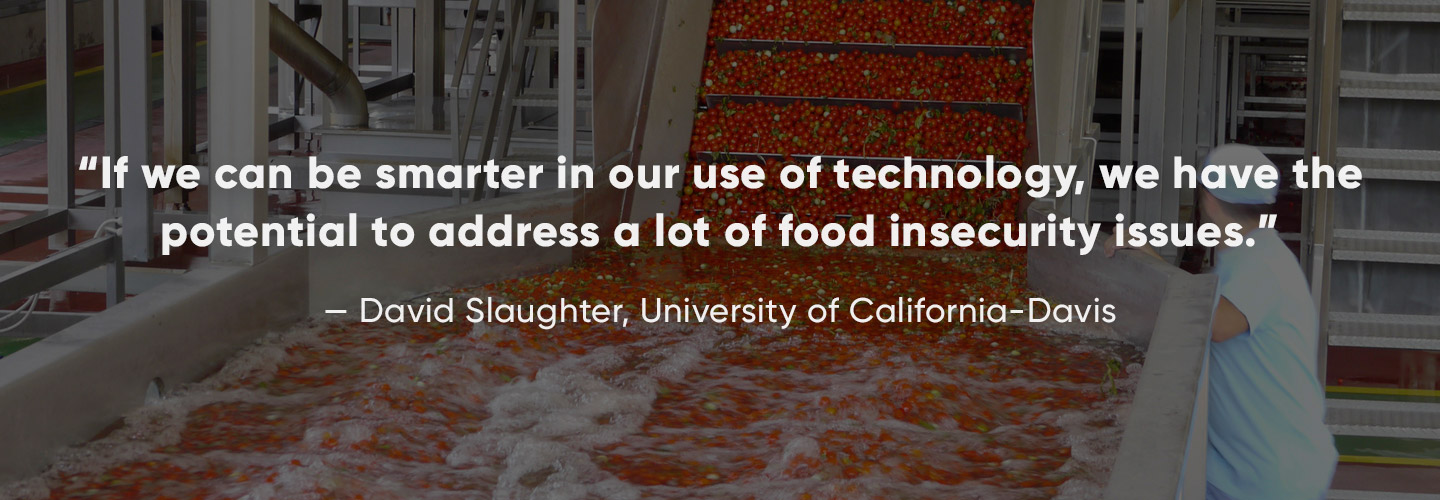The Food Chain, Digitized
Efforts to build a transparent, highly resilient food supply chain are moving forward. The benefits range from better matching of supply and demand to greater global food security.

A hungry shopper rushes through a supermarket, snags a box of steel-cut oatmeal from a shelf, grabs a carton of cranberries from the produce section, checks out, and heads home for a healthy breakfast. In doing so, she unknowingly sends a message to players up and down the food supply chain.
Her choices, along with those of millions of other consumers, form a vast information stream that guides decisions by the retailers, food processors and farmers who determine the quantity, quality and composition of the world's food supply.
Matching food production decisions with customer preferences has never been more important. An estimated third of the food produced worldwide goes to waste, due largely to crops lost to pests and disease, spoilage of unwanted inventory and crops left to wither because market prices wouldn't cover harvesting costs. That's unsustainable in light of projections that global population growth will boost total food demand by 70 percent by 2050.
Concerns about worldwide food security aren't the only source of pressure on the food supply chain, which also faces increasing—and increasingly fickle—consumer demand for greater variety, faster delivery, fresher food, and more information about how their food is grown and processed.
These challenges set the stage for a wholesale digital transformation of a food industry in search of better tools to forecast demand, boost output, shorten lead times, improve efficiency and reduce waste. “If we can be smarter in our use of technology, we have the potential to address a lot of these food insecurity issues,” says Professor David Slaughter of the University of California-Davis, who oversees the university's “Smart Farm” initiative, aimed at improving agricultural productivity through technology.

The agriculture industry’s adoption of technologies like wireless sensors, data analytics, farm and factory automation, cloud computing and artificial intelligence is still limited. But a look at our shopper's ripple effects shows how digital advances can ultimately create an integrated, efficient, resilient, transparent food ecosystem capable of meeting the world's present and future food needs.
Shopping smart
Initially, our shopper's choice alerts grocery store managers that they're running low on oatmeal and cranberries. Many chains are testing automated “smart shelf” replenishment systems with sensors that detect empty shelves, cue restocking when shelves go bare and automatically initiate new orders when inventory falls below anticipated demand levels. These systems reduce “stock-outs” that frustrate shoppers and cost retailers an estimated 4 percent of total revenue.
Food retailers also funnel information from point-of-sale systems, loyalty programs, and even social media into data analytics platforms to determine which products are most popular at individual stores, and which are trending up or down. These insights reveal variations in demand across large chains, enabling retailers to order the right amount of each product for every store.
Some retailers are augmenting their supply chains by adding external data such as weather patterns to their analytics platforms. For example, correlations between buying patterns and cold snaps showed U.K.-based Tesco, Europe's largest grocery chain, that cat food demand rises when it’s cold. So the retailer orders more cat food when temperatures fall, ensuring it never loses a sale due to stock-outs.
At major chains like Walmart, the U.S.’s largest grocer, much of this activity is automated, and based on predictive analytics. Their data systems send insights upstream to suppliers, alerting them to likely shifts in demand. These seamless digital networks reduce costly stock-outs of popular products and minimize inventories of slower-selling items.
Smaller retailers, many of which cannot afford such high-powered systems, can rely on manufacturers to provide the necessary digital supply chain capabilities. U.S.-based Pepsico, for example, tracks sales and inventories at mom-and-pop stores, using that information to create the “perfect order” for each outlet. Robotic pickers in highly automated distribution centers pluck the right number of bags of Fritos and send them on in customized cases of merchandise to each store on its drivers’ delivery routes.
Network effects
That purchase of oatmeal and cranberries also echoes down through the cloud-based digital supply chain to distributors. In response, they clear space for more shipments and route stocks to warehouses nearest the stores where sales of these groceries are rising. The distributors also feed data on the expected rise in cranberry shipments into digital logistics platforms that line up sufficient trucking capacity to deliver the perishable fruit to stores on a just-in-time basis, minimizing spoilage.
"Real-time information on how much food is on the way to distributors’ warehouses, and when it will arrive, helps distributors anticipate and respond to potential supply disruptions while ensuring that each store gets the inventory it needs. Sensors attached to shipping palettes and to packaging improve warehouse operations, matching labor and logistics capacity more closely to demand and to retailers' delivery requirements."
At their “digital warehouse of the future” in Leicestershire, England, U.S.-based logistics provider XPO and Swiss packaged foods giant Nestlé have set up a futuristic warehouse showcasing the power of digitization. Here, automated sorting and robotic picking maximize productivity, while predictive data analytics enhances just-in-time inventory capabilities and reduces stock-outs.
Food, just in time
When our early-morning shopper bought her breakfast groceries, her retailer’s point-of-sale system digitally alerted the relevant food processors. This data, combined with a recent uptick in interest in steel-cut oatmeal on social media, enabled the cereal manufacturer to anticipate rising demand for her product. They might then automatically order more of those oats and ramp up production by switching over factory lines that had been making other varieties.
None of this would be possible without factory automation systems, coupled with sensors and Internet of Things capabilities, that keep production lines humming to maximize throughput, the key to meeting shorter lead times, reducing waste and producing more food. For example, global snack company Mondelēz, based in the U.S., has invested billions in highly automated, modular “lines of the future” that can be reconfigured rapidly to switch production from one product variety to another as demand patterns shift.
U.S.-based cereal maker Kellogg is pursuing a similar modernization project, digitizing a global supply chain spanning 50 plants in 26 countries. A.I., automation and analytics are improving functions from procurement to production, distribution and demand forecasting, says Alistair Hirst, the company’s senior vice president in charge of its global supply chain. “This will transform our operations into an end-to-end, digital supply network that integrates commercial demand signals throughout an intelligent ecosystem of planners, suppliers, factories, and distribution partners,” he notes, adding that technology is improving “yield, productivity, operating efficiency, quality measures, inventory, predictive maintenance to equipment, and service to our customers, to name a few.”
Data at the source
In an open food supply chain based in the cloud, signs of increasing demand for oats and cranberries soon reach farmers. And digitization gives them new tools to respond accordingly. Sensors, data analytics and hyper-local weather forecasts provide granular data on soil composition, climate conditions and livestock health, down to the individual acre and cow. They can use this information to adjust irrigation, seeding, fertilization and animal feeding, and thus boost yields. Some dairy farmers in North America are even using facial-recognition technology to monitor bovine behavior for signs of illness that could affect milk production.
Data on farming conditions and production levels can then be transmitted directly to food processors, alerting them to trends in product quality, supply volumes and likely timing of shipments. Chickens grow more slowly when it’s hotter, for example, so Tyson Foods tracks temperatures in chicken-raising regions to help judge the future supply of chickens.
A.I. and analytics also help farmers maximize income while minimizing losses and waste. Platforms accessible via mobile devices analyze pricing data from sources ranging from local grain elevators to futures markets, and provide deeper insight into production costs. With a few taps of the screen, an oat farmer can see cost profiles and yield histories for each acre, then check pricing to determine the likely return on every additional acre planted with oats.
“Farmers can more effectively market grain and improve their profitability using technology and data analytics,” said Roger Watchorn, president of North American supply chain at Cargill, which recently joined forces with ADM to offer grain growers a consolidated digital platform providing comprehensive data to support production and marketing decisions.
Big opportunity, slow start
The great virtue of open, transparent ecosystems is that they work in both directions. Everyone from the farmer to the retailer knows what's selling and what isn't—and can act accordingly. Clearer price signals improve decision-making throughout the food chain, preventing supply-demand mismatches that can lead to shortages or overproduction.
Most importantly, digitization makes the challenge of global food security less daunting. Forecasters with access to detailed, up-to-the-minute information from growing regions can sound a timely alarm over safety issues, weather conditions and other developments that could disrupt food supplies. And as technology reduces waste and increases output at each stage of food production, the odds of feeding the world's growing population improve.
As technology reduces waste and increases output at each stage of food production, the odds of feeding the world's growing population improve.
But digital technologies have yet to achieve the widespread adoption necessary to transform the food supply chain. Only about a third of companies in the industry around the world have implemented data analytics, leaving large gaps that impede the automated collaboration essential to capturing the full potential of digitization. Until everyone invests in digital capabilities—a challenge, especially for farmers in developing countries—the integrated, transparent, resilient food ecosystem will remain a promising, but unrealized, vision.
Additional Links
Building Resilient Food Systems